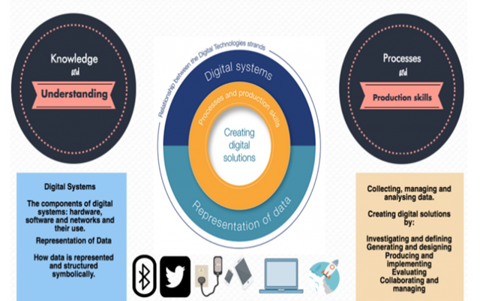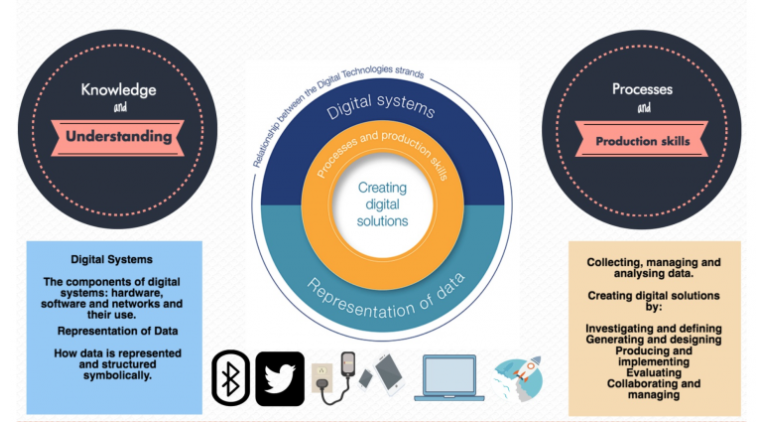Writing a Letter to the Future

About this school story
In 2015, the parents and teachers of Oakleigh State School in Queensland were invited to write a letter to the future. The outcomes of that activity created an ambitious vision for students and the learning that would be offered at the school.
Year band: 1-2, 3-4, 5-6, 7-8
A Letter to the Future

Nicola Flanagan is the Head of Innovation at Oakleigh State School
View the full infographic detailing Oakleigh's Implementation of the Digital Technologies Curriculum here.
In 2015, our community embarked on a mission to create a collaborative vision that would guide us through the coming four years. We used a collaborative process to give everyone a sense of shared ownership. The first stage was to offer our community of adult learners – our parents and our teachers – the opportunity to write a letter to the future. Each person imagined themselves in four years’ time, and reflected on the changes they had witnessed in our school and in our learners. The letters were then analysed and commonalities found.
To enable as many people as possible to be part of our visioning process, a van was set up on our school site for a week. Our community was invited to spend time in the van, providing feedback, ideas and recordings about the future of the school – both physical and pedagogical. The van was set up with maps of the school, iPads for recording video thoughts, scribbling sheets and drafts of vision statements as inspiration. We encouraged voting on the draft vision statements we displayed. We also engaged our student learners, encouraging them to draw their visions of future learning spaces and to talk about what learning could look like.
At the same time we engaged a consultancy, NoTosh, and began working with Tom Barrett from NoTosh on strategic development and practitioner inquiry using design thinking processes.
Tom supported us to work with the draft visions, and to use the toolset, skillset and mindset of design thinking to redesign a vision statement that was much more ambitious than the drafts. The resulting ambition – Empowering our community of learners to create a legacy which redefines our world – signified an important stage for Oakleigh State School; this vision has been a key factor in enabling us to embrace the Digital Technologies curriculum (students as creators of digital solutions) and to embark on our STEM visioning in mid-2017.
Culture of Innovation
When we embarked on our BYO devices trial in 2014, we knew that we needed to give teachers permission to trial new ways of working. This would mean supporting a culture of innovation, one in which experimenting, succeeding and sometimes failing would become an accepted way of working.
We experienced the disruptive influence of technology time and time again; the presence of portable and creative opportunities, via personal technology, meant that questions were raised about different ways of: working, assessing, providing access to materials and allowing students to communicate their understandings
Supporting a Mind-Shift
Through our work with NoTosh, we have embarked on a strategic journey to shift teachers’ mindsets in relation to inquiry. Using a model of design thinking called ‘practitioner inquiry’, our teachers have engaged in three rounds of inquiry into their own practice over the last two years. In encouraging this reflective practice we are also giving teachers experience of a process that promotes critical and creative thinking while also supporting inquiry.
This framework of practitioner inquiry has supported different areas of our school’s improvement agenda, including:
- writing
- extension and enhancement
- numeracy and digital technologies.
Interestingly, the adoption of the practitioner inquiry framework to support our teachers with their own inquiries, is also providing them with genuine insights into design thinking – one of the three types of thinking required for successful interaction with the Technologies curriculum. The advantages of this experience cannot be overstated.
Adopting the DT curriculum
When Education Queensland announced the fast-tracking of the Digital Technologies curriculum, we were one of a group of schools encouraged to be ‘early launch schools’. More enthusiastic early adopters than ‘launch schools’, we joined a group of schools that saw this new curriculum as a genuine opportunity for our learners. At Oakleigh State School, we knew we were in an excellent position to explore this new curriculum because of what we had already experienced in our journey.
In 2016, the first year of the program, we worked with at least one volunteer teacher per year level to explore the curriculum. This allowed us to experiment and to find the alignments between the Digital Technologies curriculum and other learning areas, without the pressure of assessment. In whole-school staff meetings, we unpacked the curriculum with the aid of infographics that we had created to make the curriculum more user friendly. We were very aware that this was a brand new curriculum and that taking our time was going to be the best course of action for our whole community of learners.
Other Learning Areas
In spending a year exploring and familiarising ourselves with the curriculum, we found that there were many areas of alignment within the curriculum. With digital solutions needing a context, there were opportunities in the upper year levels to link with areas such as Mathematics and Geography. For the junior areas of the school, we found learning areas such as Mathematics provided a perfect link for our teachers and students.
In that year we encouraged teachers to go further than just exploring if they felt they wanted to. Within Year 5, a whole Digital Technologies unit was implemented. The students created a digital solution for their communities to prepare them for natural disaster. In Year 6, Geography quizzes were created to assist Year 3 with their Geography knowledge, and infographics were created as a way of analysing and representing data. In Year 4, teachers and students experimented with visual programming tools to explore maths concepts. Our Literacy Specialist worked with Prep to Year 3, and our Digital Learning Coordinator coached other teachers. Find a detailed outline of this curriculum alignment in the PowerPoint presentation Digital Technologies curriculum mapping: Finding alignment and connection within curriculum.

© Mt Cootha Cluster and Oakleigh State School
In 2017, to make further progress with this curriculum, we are implementing and assessing in each year level a limited number of content descriptions. This has involved further whole-staff learning sessions, further sharing on our TechWEB, the facilitation of a conference for educators around Brisbane held by our staff and half-day planning sessions for design of an assessment item.
Tips
These tips have been provided by the Principal of Oakleigh State School, Grant Baker.
- Start small but start.
- Encourage school leaders to see that this does not need to be a whole other curriculum area – but that it has the potential to support other curriculum areas. Support teachers to make connections between the Digital Technologies curriculum and other areas of the curriculum and do this at the unit planning and design stage.
- Start where success is most likely and allow the success to spread.
- After there is success, allow people to spread the narrative.
About OSS
Oakleigh State School is located in the inner west Brisbane suburb of Ashgrove.

